By Mauricio Alvarez
Our planet is in a process of accelerated degradation which could lead to the collapse of our civilization, if we do not take collective action now.
Despite the recent increase in publications on this subject, the origin of this change, which some call Anthropocene (1), dates back to the middle of the 18th century with the emergence of the Industrial Revolution in England.
The work of scientists, such as anthropologists or experts on climate change, allows us to conclude that human activities have left a deep and almost irreversible imprint on the geological and climatic history of our planet, endangering l the very existence of our species.
The limits of growth: a first global alert in 1972
For more than two centuries, practically no one has been interested in the impact of our way of life on the planet, which is understandable, because who could have imagined that human beings could cause an irreversible impact on a large scale?
Nevertheless, in 1972, a report commissioned from the Massachusetts Institute of Technology (MIT) by the Club de Rome was published. Its authors entitled it: “The limits of growth” (2). Such a report would forever change our perception of the situation. At least for the “leaders” of the planet, it was already almost impossible to ignore the possible consequences of the economic and social model that had been built.
For example, the report’s first conclusion was unequivocal: “If the current increase in world population, industrialization, pollution, food production and exploitation of natural resources remains unchanged, it will reach the absolute limits to growth on Earth over the next hundred years. The most likely result will be a fairly sudden and uncontrollable decline in population and industrial capacity “(3).
The report alerted us to the need to monitor the rise in certain ecological and socio-economic indicators which, if not stabilized, could have undesirable consequences on our planet, even endangering our survival.
Summits on climate change, and the results?
More than 20 years had to pass since the report “The limits of growth” for a first international summit on climate change to be held (4). In 1992, the United Nations organized the first conference of the parties on the Climate Change (COP) in Rio de Janeiro, Brazil.
These are international meetings, which bring together leaders from around the world each year to make decisions to meet the emission reduction commitments necessary to stem the climate crisis we are experiencing. We had to wait 21 summits, until in 2015, the Paris agreement on climate change (COP21) becomes a global treaty ratified unanimously by the 196 delegations (195 States + the European Union). With the Paris Agreement, it was decided to take all necessary actions to keep the increase in average global temperature below 2 degrees celsius and to make additional efforts to keep it below 1.5 degrees celsius, compared to pre-industrial temperatures. These objectives have been defined on the basis of scientific recommendations, in order to avoid irreversible damage to our planet.
Despite the goodwill shown by political and economic players with the Paris Agreement on climate change, the final objectives today seem difficult to achieve. At the end of 2018, before COP24, in Poland, only 16 of the 197 signatories to the Paris agreement defined a climate action plan to fulfill their commitment (5).
Meanwhile, heat waves, rising sea levels, etc. are intensifying on the planet.
Collapse: how to prepare for the worst?
Despite many alarming scientific reports in recent decades (6), the vast majority of human beings continue on their way, indifferent to what can happen. The capitalist model continues to dominate, creating such inertia that even the most willing politicians are incapable of implementing effective action plans to reverse this “suicidal” tendency.
The situation is such that in recent years, the theory of collapse has begun to democratize, a neologism which makes it possible to study the possible fall of our industrial civilization, which could be defined as: “the process at the end of which the basic needs: water, food, housing, clothing, energy, etc. are no longer provided (at reasonable cost) to the majority of the population by services within the framework of the law “(7).
It is true that the picture seems grim and hopeless, but there may be a ray of hope behind this sad eventuality. Preparing for the collapse will not prevent the disaster, but it may delay it and make it less painful.
The studies are clear, the figures are indisputable, we have reached the end of a cycle. Even the Covid 19 pandemic is trying to remind us that we have to slow down, think, imagine and build another model. The ideal would be to be able to find the lost paradise that this planet was at the time of the hunter-gatherers, but this possibility seems distant. However, it is time to create new utopias, with inspiring stories that take us by the hand towards a post-capitalist world, where spirituality, mutual aid and deep respect for nature reign, of which we are a part.
(1) The Anthropocene concept was invented in 2000 by the Dutch Nobel Prize in chemistry Paul Crutzen. His view was that the name of the current geological era should reflect the impact of man on Earth.
(2) « The limits to growth » : available free in English at https://clubofrome.org/publication/the-limits-to-growth/
(3) Source : « Les limites de la croissance », page 23.
(4) COP 21: https://www.gouvernement.fr/action/la-cop-21
(5 ) Only 16 countries out of 197 respect the Paris agreement on climate change 29.10.2018 https://www.euractiv.fr/
(6) IPCC IPBES or Global Environment Outlook (GE) reports published periodically by the PNUE (ONU)










